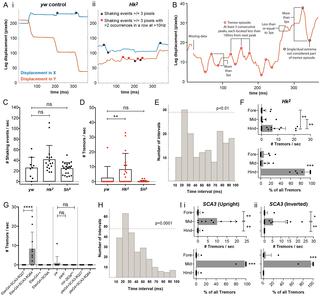当前位置:
X-MOL 学术
›
PLOS Biol.
›
论文详情
Our official English website, www.x-mol.net, welcomes your
feedback! (Note: you will need to create a separate account there.)
Fully automated leg tracking of Drosophila neurodegeneration models reveals distinct conserved movement signatures.
PLOS Biology ( IF 7.8 ) Pub Date : 2019-06-27 , DOI: 10.1371/journal.pbio.3000346 Shuang Wu 1 , Kah Junn Tan 2 , Lakshmi Narasimhan Govindarajan 1 , James Charles Stewart 2, 3 , Lin Gu 1 , Joses Wei Hao Ho 2, 3 , Malvika Katarya 2 , Boon Hui Wong 4 , Eng-King Tan 5 , Daiqin Li 4 , Adam Claridge-Chang 2, 3 , Camilo Libedinsky 2, 6, 7 , Li Cheng 1, 8 , Sherry Shiying Aw 2
PLOS Biology ( IF 7.8 ) Pub Date : 2019-06-27 , DOI: 10.1371/journal.pbio.3000346 Shuang Wu 1 , Kah Junn Tan 2 , Lakshmi Narasimhan Govindarajan 1 , James Charles Stewart 2, 3 , Lin Gu 1 , Joses Wei Hao Ho 2, 3 , Malvika Katarya 2 , Boon Hui Wong 4 , Eng-King Tan 5 , Daiqin Li 4 , Adam Claridge-Chang 2, 3 , Camilo Libedinsky 2, 6, 7 , Li Cheng 1, 8 , Sherry Shiying Aw 2
Affiliation

|
Some neurodegenerative diseases, like Parkinsons Disease (PD) and Spinocerebellar ataxia 3 (SCA3), are associated with distinct, altered gait and tremor movements that are reflective of the underlying disease etiology. Drosophila melanogaster models of neurodegeneration have illuminated our understanding of the molecular mechanisms of disease. However, it is unknown whether specific gait and tremor dysfunctions also occur in fly disease mutants. To answer this question, we developed a machine-learning image-analysis program, Feature Learning-based LImb segmentation and Tracking (FLLIT), that automatically tracks leg claw positions of freely moving flies recorded on high-speed video, producing a series of gait measurements. Notably, unlike other machine-learning methods, FLLIT generates its own training sets and does not require user-annotated images for learning. Using FLLIT, we carried out high-throughput and high-resolution analysis of gait and tremor features in Drosophila neurodegeneration mutants for the first time. We found that fly models of PD and SCA3 exhibited markedly different walking gait and tremor signatures, which recapitulated characteristics of the respective human diseases. Selective expression of mutant SCA3 in dopaminergic neurons led to a gait signature that more closely resembled those of PD flies. This suggests that the behavioral phenotype depends on the neurons affected rather than the specific nature of the mutation. Different mutations produced tremors in distinct leg pairs, indicating that different motor circuits were affected. Using this approach, fly models can be used to dissect the neurogenetic mechanisms that underlie movement disorders.
中文翻译:

果蝇神经变性模型的全自动腿部追踪揭示了独特的保守运动特征。
一些神经退行性疾病,如帕金森病(PD)和脊髓小脑性共济失调3(SCA3),与明显的步态和震颤运动变化相关,反映了潜在的疾病病因。果蝇的神经变性模型已经阐明了我们对疾病分子机制的理解。但是,尚不清楚在蝇病突变体中是否还发生了特定的步态和震颤功能障碍。为了回答这个问题,我们开发了一种机器学习图像分析程序,即基于特征学习的肢体分割和跟踪(FLLIT),该程序可以自动跟踪记录在高速视频中的自由移动苍蝇的腿爪位置,从而产生一系列步态测量。值得注意的是,与其他机器学习方法不同,FLLIT生成自己的训练集,不需要用户注释的图像即可学习。使用FLLIT,我们首次对果蝇神经变性突变体的步态和震颤特征进行了高通量和高分辨率分析。我们发现,PD和SCA3的飞行模型表现出明显不同的步行步态和震颤特征,从而概括了各自人类疾病的特征。多巴胺能神经元中突变SCA3的选择性表达导致步态特征更接近于PD苍蝇。这表明行为表型取决于受影响的神经元,而不是突变的特定性质。不同的突变在不同的腿对中产生震颤,表明不同的运动回路受到影响。使用这种方法,
更新日期:2019-07-02
中文翻译:

果蝇神经变性模型的全自动腿部追踪揭示了独特的保守运动特征。
一些神经退行性疾病,如帕金森病(PD)和脊髓小脑性共济失调3(SCA3),与明显的步态和震颤运动变化相关,反映了潜在的疾病病因。果蝇的神经变性模型已经阐明了我们对疾病分子机制的理解。但是,尚不清楚在蝇病突变体中是否还发生了特定的步态和震颤功能障碍。为了回答这个问题,我们开发了一种机器学习图像分析程序,即基于特征学习的肢体分割和跟踪(FLLIT),该程序可以自动跟踪记录在高速视频中的自由移动苍蝇的腿爪位置,从而产生一系列步态测量。值得注意的是,与其他机器学习方法不同,FLLIT生成自己的训练集,不需要用户注释的图像即可学习。使用FLLIT,我们首次对果蝇神经变性突变体的步态和震颤特征进行了高通量和高分辨率分析。我们发现,PD和SCA3的飞行模型表现出明显不同的步行步态和震颤特征,从而概括了各自人类疾病的特征。多巴胺能神经元中突变SCA3的选择性表达导致步态特征更接近于PD苍蝇。这表明行为表型取决于受影响的神经元,而不是突变的特定性质。不同的突变在不同的腿对中产生震颤,表明不同的运动回路受到影响。使用这种方法,












































 京公网安备 11010802027423号
京公网安备 11010802027423号